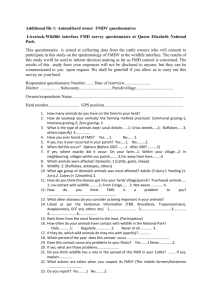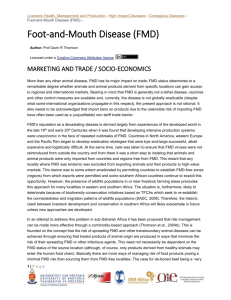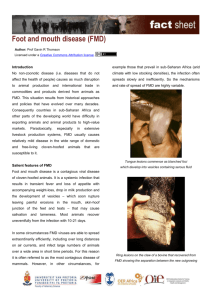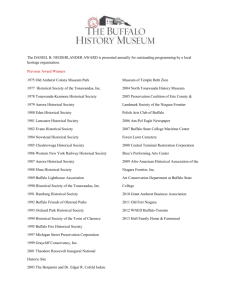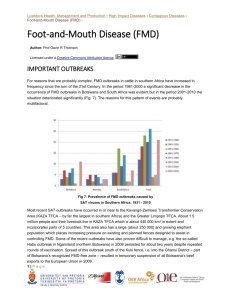foot__mouth_disease_2_epidemiology
advertisement
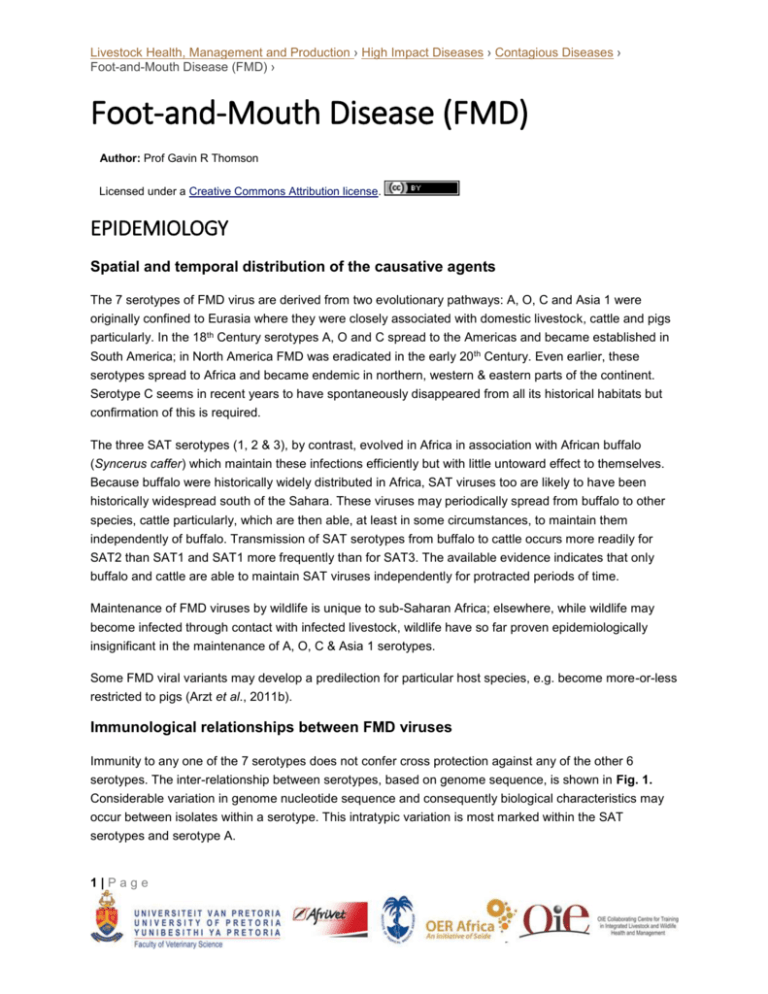
Livestock Health, Management and Production › High Impact Diseases › Contagious Diseases › Foot-and-Mouth Disease (FMD) › Foot-and-Mouth Disease (FMD) Author: Prof Gavin R Thomson Licensed under a Creative Commons Attribution license. EPIDEMIOLOGY Spatial and temporal distribution of the causative agents The 7 serotypes of FMD virus are derived from two evolutionary pathways: A, O, C and Asia 1 were originally confined to Eurasia where they were closely associated with domestic livestock, cattle and pigs particularly. In the 18th Century serotypes A, O and C spread to the Americas and became established in South America; in North America FMD was eradicated in the early 20th Century. Even earlier, these serotypes spread to Africa and became endemic in northern, western & eastern parts of the continent. Serotype C seems in recent years to have spontaneously disappeared from all its historical habitats but confirmation of this is required. The three SAT serotypes (1, 2 & 3), by contrast, evolved in Africa in association with African buffalo (Syncerus caffer) which maintain these infections efficiently but with little untoward effect to themselves. Because buffalo were historically widely distributed in Africa, SAT viruses too are likely to have been historically widespread south of the Sahara. These viruses may periodically spread from buffalo to other species, cattle particularly, which are then able, at least in some circumstances, to maintain them independently of buffalo. Transmission of SAT serotypes from buffalo to cattle occurs more readily for SAT2 than SAT1 and SAT1 more frequently than for SAT3. The available evidence indicates that only buffalo and cattle are able to maintain SAT viruses independently for protracted periods of time. Maintenance of FMD viruses by wildlife is unique to sub-Saharan Africa; elsewhere, while wildlife may become infected through contact with infected livestock, wildlife have so far proven epidemiologically insignificant in the maintenance of A, O, C & Asia 1 serotypes. Some FMD viral variants may develop a predilection for particular host species, e.g. become more-or-less restricted to pigs (Arzt et al., 2011b). Immunological relationships between FMD viruses Immunity to any one of the 7 serotypes does not confer cross protection against any of the other 6 serotypes. The inter-relationship between serotypes, based on genome sequence, is shown in Fig. 1. Considerable variation in genome nucleotide sequence and consequently biological characteristics may occur between isolates within a serotype. This intratypic variation is most marked within the SAT serotypes and serotype A. 1|Page Livestock Health, Management and Production › High Impact Diseases › Contagious Diseases › Foot-and-Mouth Disease (FMD) › Fig 1: Neighbour-joining tree showing SAT3-type buffalo virus lineages and topotypes in southern Africa Because FMD viruses like most RNA viruses evolve rapidly, viruses prevalent within different ecosystems evolve independently and consequently the geographic distribution of genotypes within a serotype is often well known. Genotypes that have a particular geographic distribution are known as ‘topotypes’. Through sequencing of the genomes, or parts of the genomes, and comparing the sequences with those of viruses contained in data-bases, the origin of viruses that cause outbreaks in new locations can 2|Page Livestock Health, Management and Production › High Impact Diseases › Contagious Diseases › Foot-and-Mouth Disease (FMD) › frequently be inferred. This field of molecular epidemiology has added a new dimension to our ability to trace or track the spread on FMD viruses, both world-wide and more locally in southern Africa (Bastos et al., 2003). Geographic distribution of SAT3 buffalo virus topotypes in southern Africa Epidemiological patterns FMD has a complex epidemiology; not only because of the viral diversity summarised above but also because of differences in the interaction between various host species and particular viral variants (sometimes incorrectly referred to as ‘strains’) as well as environmental factors. As a result, the way the disease presents in different parts of the world may differ widely. A further factor relates to the reaction of people – official veterinary services, farmer groups, conservationists, politicians and the general public – to the disease. In some parts of the world this has resulted in irrational reaction to the occurrence of the disease. FMD has even been referred to as ‘a manufactured plague’ (Woods, 2004). Thus what distinguishes FMD from most other animal diseases is the reaction, hysteria even, which its occurrence engenders. That can be more harmful than the disease itself. Much of southern Africa differs from the rest of sub-Saharan Africa in relation to FMD because only the SAT serotypes occur endemically ‒ maintained by African buffalo. The latter are increasingly restricted to 3|Page Livestock Health, Management and Production › High Impact Diseases › Contagious Diseases › Foot-and-Mouth Disease (FMD) › conservation areas. Periodically, and increasingly since the turn of the 21st Century, SAT infections ‒ SAT2 especially ‒ has spread from buffalo populations to cattle in and around conservation areas. This problem is likely to be compounded in future by the establishment of new and/or enlargement of transfrontier conservation areas (TFCAs) in southern Africa as part of bio-diversity conservation initiatives (SADC, 2008). Transmission FMD is a directly transmitted disease with the predominant means of spread being direct or close contact between infected and susceptible animals. However, less frequently, transmission may occur indirectly through infection enabled by transporting healthy animals in vehicles which have previously transported infected livestock or through people handling healthy animals soon after being in contact with infected ones. Other mechanisms of local spread ‒ such as short-distance air-borne transmission during outbreaks ‒ are suspected but unequivocal evidence is yet to be provided in this respect. Much confusion has resulted from the finding in northern Europe that long-distance transmission has very rarely occurred through virus-containing aerosols being transported for many kilometers by air currents (i.e. air-borne spread). For this form of transmission to occur, a number of climatic and epidemiological circumstances need to prevail including a potent source of infection ‒ usually large piggeries suffering an explosive outbreak (because pigs excrete FMD virus more efficiently than other animals) ‒ high density of susceptible animals, cool temperature, often involving temperature inversion that prevents convection, gentle wind blowing in a constant direction and cattle as recipients of the aerosols, because cattle are more susceptible to aerosol infection than other species owing to their large inspiratory volume (Thomson & Bastos, 2004a). In tropical/sub-tropical climates these requirements are seldom, if ever, met. A recent publication has postulated that aerosols may be derived from the skin of infected animals but that remains to be proven (Dillon, 2011). Among ruminants, cattle certainly, infection usually occurs via the respiratory tract and cattle may be infected by small numbers of infectious virions (Thomson & Bastos, 2004a). Conversely, large amounts of infectivity are required to cause infection by the oral route in cattle. In pigs by contrast, the oral route of infection is most common with infection resulting from the feeding of pigs with untreated swill being a common source of FMD outbreaks in Europe and Asia. There has only been one recorded case of this type of outbreak in southern Africa. It has been shown experimentally that animals infected with a FMD virus may excrete significant amounts of ‘infectivity’ for up to 3 days before obvious clinical signs develop and this has been considered epidemiologically important. Recently, however, it was shown in a series of experiments in cattle that the amounts of virus excreted before the development of clinical signs were insufficient to result in transmission; only about half a day after clinical signs developed did transmission occur (Charleston et al., 2011). It remains to be proven that this finding reflects the norm but if so it would simplify the management of FMD outbreaks. 4|Page Livestock Health, Management and Production › High Impact Diseases › Contagious Diseases › Foot-and-Mouth Disease (FMD) › For reasons not fully understood but probably to some extent related to the species predilection of SAT viruses, sheep and goats are only infrequently infected during FMD outbreaks in eastern and southern Africa but this is not invariably the case (Thomson & Bastos, 2004a; Arzt et al., 2011a). For SAT-serotype infections in southern Africa the usual start of FMD outbreaks in livestock results from close contact between infected buffalo and susceptible cattle (Thomson & Bastos, 2004a). However, because buffalo rarely show evidence of disease the mechanism whereby this occurs is open to conjecture. There is good evidence that within breeding herds of buffalo, young animals become infected more-or-less simultaneously when a significant cohort of susceptible calves builds up within breeding herds and that at such times these animals contaminate the environment with FMD virus. This has been inferred from the fact that most young buffalo have actively acquired antibody to all 3 SAT serotypes by the time they reach one year of age and, secondly, that buffalo cows in southern Africa calve predominantly in mid-summer (December-February). The calves therefore lose their maternally-derived immunity more-or-less synchronously over the next 3-6 months. Thus by approximately May-July, when water is scarce and buffalo and other ungulates, including cattle, tend to congregate around water points, buffalo herds likely present a source of infection for other susceptible animals which come in close proximity to them. Probably less frequently buffalo-cattle transmission occurs between susceptible cattle and so-called ‘carrier buffalo’. These are buffalo which have recovered from the acute phase of infection (i.e. at least 4 weeks after initial infection) but, while the virus disappears from all other tissues, (with the possible exception of lymph nodes ‒ Juleff et al., 2011), secretions and excretions, it persists in the oesophageopharyngeal (O/P) mucosa of 50% or more of individual buffalo, i.e. carriers, for a variable period. Some individuals may remain carriers for periods of 5 years or more. However, it has been shown experimentally that carriers rarely transmit SAT viruses to cattle with which they have been in close contact for periods of several months (Thomson & Bastos, 2004a). Transmission of SAT viruses to cattle by carrier buffalo is therefore inefficient at best. The issue of carrier transmission between cattle is a contentious issue but it is clear that cattle are less effective carriers of FMD viruses than African buffalo. Nevertheless, up to 50% of cattle retain the infecting virus in the O/P mucosa for periods as long as 6 months and even longer in some circumstances. However, proof of carrier transmission between cattle, despite careful investigation, is lacking. For other ruminants where virus may persist in the O/P mucosa for shorter periods than in buffalo and cattle such as sheep and goats, the probability of ‘carrier’ transmission occurring is probably remote. However, the issue of carrier animals remains ‒ probably unjustifiably ‒ an important consideration in the international control of FMD (Arzt et al., 2011a). The role of free-living wildlife other than buffalo in the maintenance and spread of FMD in southern Africa has important implications for management of the disease. A longitudinal study conducted in the Kruger National Park (KNP) in South Africa over a 10 year period has shown that impala (Aepyceros melampus) in some parts of the KNP regularly become infected by buffalo herds in the vicinity and that most of these infections do not result in disease (Bastos et al., 2000; Vosloo et al., 2009). Furthermore, historical data 5|Page Livestock Health, Management and Production › High Impact Diseases › Contagious Diseases › Foot-and-Mouth Disease (FMD) › suggest that on occasion in the past impala have been instrumental in transmitting the infection to cattle. This is an important factor in the management of FMD in southern Africa, especially in relation to design of fencing systems for separation of animal populations. 6|Page

